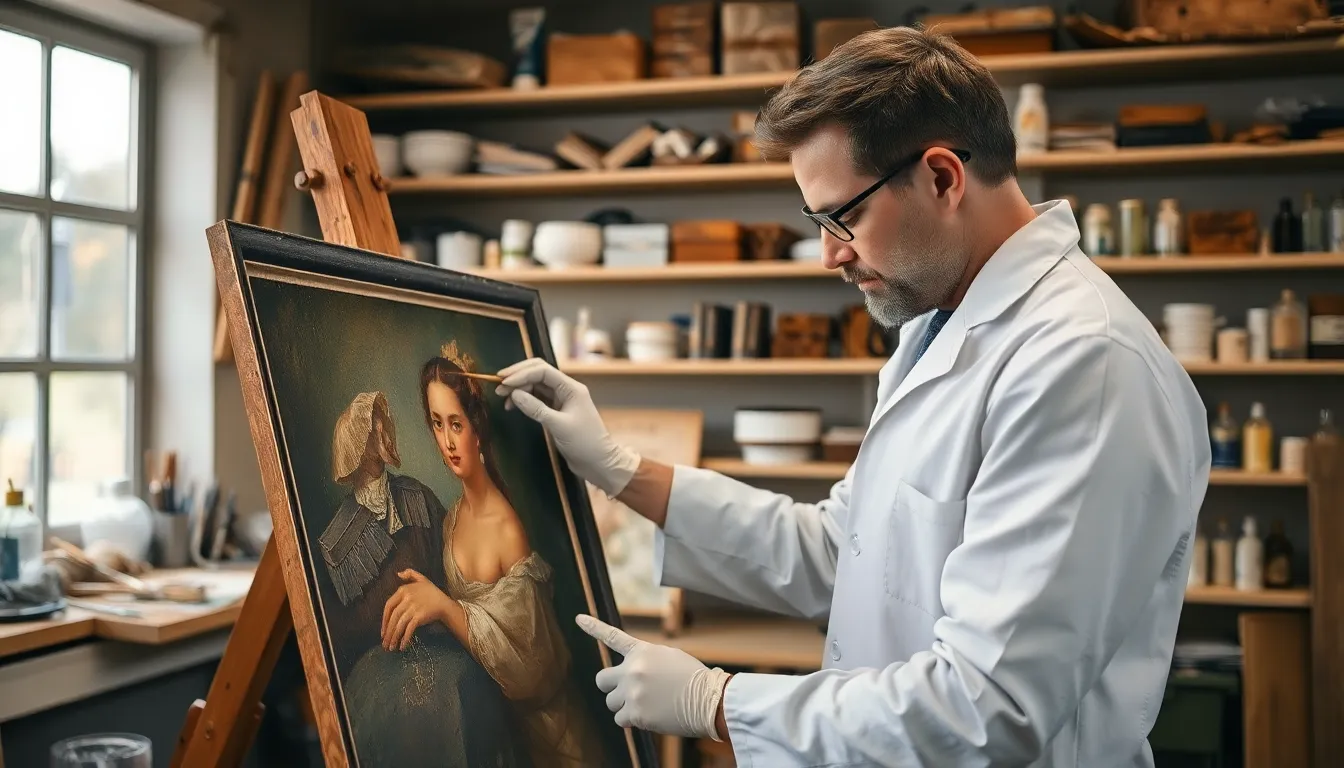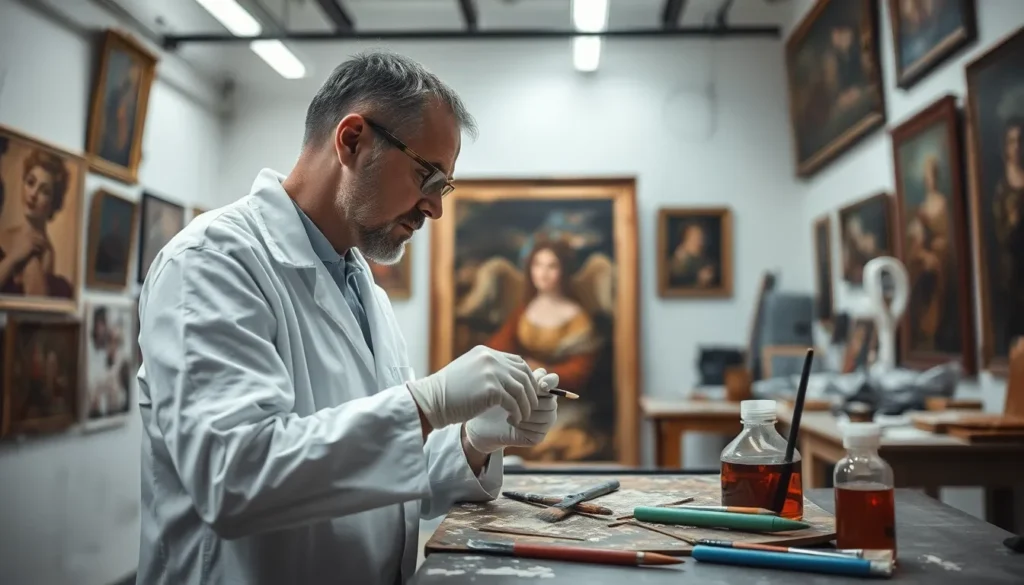Table of Contents
ToggleIn a world where masterpieces can fade faster than a bad haircut, restoring artworks has become an essential craft. Imagine finding a long-lost painting hidden behind a dusty old couch—restoration experts swoop in like art superheroes, bringing color and life back to the canvas. They wield brushes and solvents instead of capes, but their magic is just as captivating.
Restoration isn’t just about fixing what’s broken; it’s about preserving history and culture for future generations. Every crack and discoloration tells a story, and skilled restorers know how to listen. Whether it’s a Renaissance painting or a modern masterpiece, the art of restoration transforms forgotten treasures into vibrant symbols of creativity. So, let’s dive into the fascinating world of restoring artworks and discover how these unsung heroes breathe new life into our artistic heritage.
Overview of Restoring Artworks
Restoring artworks serves as a crucial practice in preserving history and culture. Restoration techniques encompass cleaning, repairing, and stabilizing damaged pieces. Experts in the field utilize specialized tools and materials for each unique situation.
Many artworks face deterioration due to environmental factors, age, and improper handling. Factors such as humidity, light exposure, and pollutants contribute significantly to the decline of these pieces. Awareness of these influences helps restorers develop effective strategies to prolong the life of artworks.
Understanding the artwork’s provenance plays an essential role in restoration. Knowing the artist’s techniques and materials used informs decisions regarding restoration methods. Inclusivity of historical context ensures that restorations honor the original intent and narrative behind each piece.
Collaboration among professionals also enhances restoration efforts. Art conservators, chemists, and historians work together to address complex restoration challenges. Cross-disciplinary cooperation leads to innovative approaches and solutions in the restoration process.
Despite the complexities, the goal remains straightforward: to revive and preserve the beauty of art. Each restoration not only brings back the visual impact but also reinstates cultural significance. Through thoughtful restoration practices, current and future generations can appreciate and learn from these vital pieces of our collective heritage.
Techniques Used in Restoring Artworks

Art restoration employs various techniques, each addressing specific needs of the artwork. Understanding these methods is essential for preserving both the physical pieces and their historical significance.
Cleaning and Conserving
Cleaning surfaces is a primary focus in art restoration. Specialists utilize gentle methods to remove dirt, dust, and contaminants without damaging the material. They often use distilled water and pH-neutral solutions for paintings. Conservators evaluate the artwork’s composition before selecting appropriate cleaning agents. Additionally, ultraviolet light helps identify underlying issues like varnish buildup. In cases where materials are fragile, specific tools assist in conserving those elements. All cleaning processes aim to reveal the original colors and details while maintaining integrity.
Repairing and Repainting
Repairing entails fixing structural damage to the artwork. Tears, cracks, and losses require meticulous attention from conservators. They often employ adhesives and fills to restore stability and form. Repainting is sometimes necessary to reinstate missing areas, though this is done cautiously to respect the creator’s intent. Technicians often use reversible materials that allow for future adjustments to be made. Balance between modern techniques and historical accuracy defines this phase, ensuring that the restored piece remains faithful to its origins while gaining renewed life.
The Importance of Restoring Artworks
Restoring artworks serves crucial roles in enriching cultural heritage and understanding history. Skilled professionals utilize specific methods to address damage while revealing the stories embedded in these pieces.
Cultural Significance
Restoration honors cultural narratives that define societies. Each artwork embodies traditions, beliefs, and values, contributing to a community’s identity. Preserving these pieces allows societies to maintain connections to their past, fostering continuity across generations. Local traditions, societal shifts, and artistic movements often find expression in restored artworks. Furthermore, exhibitions featuring restored pieces enhance public engagement with cultural history, encouraging education and appreciation. Thus, restoration goes beyond aesthetics; it safeguards cultural legacies for future appreciation.
Historical Value
Every artwork carries historical importance that restoration aims to protect. Original pieces provide insights into specific eras, revealing social, political, and economic contexts. Recovery efforts often include detailed research into the provenance of these artifacts, ensuring faithful representation of their origins. Restorers consider historical techniques, styles, and materials while seeking to preserve authenticity. Additionally, restored artworks serve educational purposes, offering tangible connections to historical events or figures. Their revival supports ongoing scholarship and discourse, enriching the understanding of art history and its evolution.
Challenges in Restoring Artworks
Restoring artworks presents various challenges that require careful consideration and skillful handling in the restoration process.
Ethical Considerations
Ethical dilemmas frequently arise in art restoration. Experts must balance artistic integrity with the need for repair. Decisions regarding whether to retain original materials or employ modern techniques often provoke debate. For instance, using synthetic materials can sometimes compromise authenticity. Restorers strive to preserve the original intent of each piece, heightening the importance of understanding provenance. Collaborating with historians adds depth to this understanding, ensuring any restoration respects historical context. Transparency in restoration practices is vital for maintaining trust with the public. An artwork’s narrative hinges on how it is treated during restoration, making ethical considerations fundamental.
Technical Limitations
Technical limitations play a significant role in the restoration of artworks. Tools and techniques continue to evolve, yet they cannot always address every issue. Specific challenges, such as fragile materials, require careful manipulation. Some restoration methods may not be suitable for every type of artwork, limiting options. Conservation materials can lack the same aging characteristics as originals, leading to mismatches in appearance. Additionally, knowledge gaps in certain restoration techniques may hinder effectiveness. Assessing the condition of an artwork accurately is essential for choosing appropriate interventions. Continuous education and innovation are crucial for overcoming these technical barriers in restoration practices.
Future Trends in Restoring Artworks
Technological advancements significantly impact the future of art restoration. 3D printing emerges as a valuable tool for replicating lost or damaged components of artworks. This technique allows for precise reconstruction, ensuring that the original intent remains intact while enhancing aesthetic appeal.
Artificial intelligence offers another innovative approach in restoration efforts. Algorithms analyze artwork condition data, predicting potential deterioration and suggesting preventative measures. By automating some processes, AI provides experts with informed insights, allowing for more efficient restoration practices.
Sustainable materials gain popularity in restoration practices. Biodegradable and environmentally friendly substances contribute to a reduced ecological footprint and maintain the integrity of the artwork. Conservationists prioritize these materials, recognizing the need for harmony between restoration and environmental stewardship.
Collaborative efforts among diverse experts also shape future trends in the field. Art conservators, scientists, and historians work together to create interdisciplinary strategies. This cooperation fosters a deeper understanding of historical context and leads to enriched restoration methods.
Outreach initiatives aim to educate the public about the restoration process. Engaging communities through workshops and demonstrations promotes a broader understanding of cultural heritage. Community involvement enhances appreciation for restored artworks and encourages local participation in preservation efforts.
Digital archiving plays a crucial role in documenting restoration processes and decisions. High-resolution imaging technology captures details, allowing for comprehensive records of each piece. Art historians utilize this information for research and education, reinforcing the historical significance of restored artworks.
Changing ethical standards continue to influence restoration practices as well. Experts navigate increasingly complex dilemmas regarding authenticity and intervention levels. Ongoing discussions surrounding these ethical considerations drive improvements in methodology and transparency in restoration processes.
Art restoration stands as a testament to humanity’s commitment to preserving cultural heritage. It not only revives artworks but also honors the stories and histories embedded within them. As techniques evolve and interdisciplinary collaboration flourishes, the future of restoration looks promising.
Innovative technologies and sustainable practices are paving the way for more effective and ethically sound methods. By engaging the public and fostering appreciation for restored pieces, communities can maintain vital connections to their past. Ultimately, the ongoing efforts in art restoration ensure that these treasures continue to inspire and educate generations to come.



